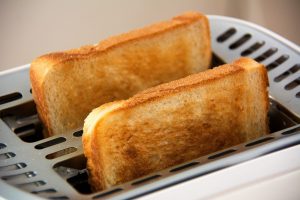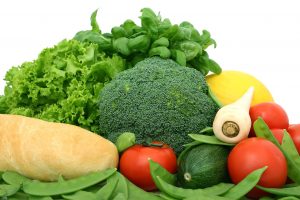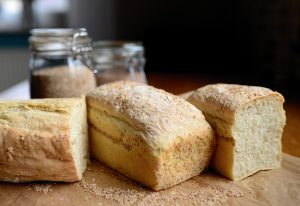Get ready to be Gluten Free?

In Latin, gluten literally means ‘glue’. Gluten is a protein (comprised of gliadin and glutenin) which is found in all forms of wheat (including durum, semolina and spelt), rye, barley and related grain hybrids such as triticale and kamut. Gluten is responsible for the elasticity and stretch of doughs and is found in an endless variety of processed foods.
Coeliac Disease and Gluten Sensitivity
Coeliac Disease (CD) is an autoimmune disease that leads to a permanent intestinal intolerance to gluten. The gluten causes inflammation of the intestinal wall and a flattening of the villi, finger-like projections that line the inside of the bowel. When these villi atrophy (flatten) the surface area for absorption is greatly reduced resulting in deficiencies of a number of nutrients. Our ability to make enzymes such as lactase, which assists in digestion of lactose (a naturally occurring sugar found in dairy) may also be compromised, resulting in secondary dairy intolerance. The overall prevalence of CD is estimated as high as 1 in approximately 130, however if you have a family history of CD your risk is increased significantly to approximately 1 in 10.
Gluten Sensitivity
Gluten Sensitivity is a condition that involves a degree of gluten intolerance without the presence of immune markers associated with CD. The treatment approach is similar and; removal of gluten often results in clinical improvement and symptom relief. After a period of avoidance, small amounts of gluten-containing foods may be well tolerated. This is best guided by your healthcare practitioner.
A Note on Oats
Oats do not contain gluten as such, however they contain a similar prolamine (protein) to gluten called avenin, which may elicit a response similar to gluten intolerance/sensitivity in some individuals. In addition, oats are often processed near other gluten-containing grains which may result in cross contamination. For these reasons Coeliac Australia does not
recommend oats as part of a gluten free diet.
Symptoms of Coeliac Disease

Although there may be no symptoms of CD, the most common ones involve the digestive system and include abdominal bloating or pain, diarrhoea, constipation, flatulence, heartburn, or nausea with or without vomiting. Other possible symptoms include sinusitis, asthma, skin disorders including eczema and dermatitis herpetiformis, fatigue, bone, joint and muscle pains, mouth ulcers, loss of tooth enamel, mood and behavioural problems, poor growth or development in children, weight loss, hair loss and menstrual
problems.
CD is associated with a higher risk of osteoporosis, iron deficiency anaemia, menstrual problems including amenorrhoea, miscarriage and infertility, and thyroid or other autoimmune diseases.
A healthcare practitioner can assist with any additional treatment you may require to help reduce any symptoms you may be experiencing, and to address any underlying health issues.
Helpful Hints for Eating Gluten Free
• Read all food labels carefully.
• The Australian Food Standards Code requires that foods labeled
as ‘gluten free’ must not contain any detectable gluten. Food labeled
as ‘low gluten’ must contain less than 0.02% gluten.
• Lactose intolerance commonly accompanies CD.
• Avoid cross contamination in the kitchen by developing gluten free
kitchen habits, storage plans and procedures for mixing, cooking
and baking.
• Gluten free breads taste better toasted and should be stored in the
fridge or freezer.
• When eating out select food without crumbing, ‘creaming’, coatings,
gravies and sauces. Most restaurants now have gluten free options;
if you’re unsure, call ahead to confirm.
• Obtain your fibre from brown rice, buckwheat, unpeeled potatoes,
fresh and dried beans & legumes, fresh fruit & vegetables.
• Nutritional deficiencies are common, particularly of iron, zinc,
vitamins B2, folate and B12.
• Avoid skipping meals, eat slowly and chew all food thoroughly. Enjoy
your food!
• Plan your meals and carry snacks with you so you are prepared for
all events.
What To Include on a Gluten free diet

Grains/Flours/Roots/Tubers and Legumes
Grains: Buckwheat, brown rice, basmati rice, wild rice, maize (corn), quinoa, amaranth, millet or sorghum. (Some CD patients may have a secondary sensitivity to the grains quinoa, amaranth, buckwheat & millet).
Roots and Tubers: Potato, tapioca, arrowroot, sweet potato, parsnip or
jerusalem artichoke.
Legumes: Beans, soy, lentils, peanut, pea or chickpea.
Flours: Any flours made from the above sources.
Breads and Cereals
Breads: Gluten free breads based on buckwheat, corn, rice, chickpea flour
and/or soya flour.
Cereals: Gluten free muesli, homemade muesli made from a combination
of: brown rice flakes, millet flakes, organic cornflakes, puffed corn, puffed
rice, raw nuts & seeds or shredded coconut.
Pastas
Buckwheat noodles, rice noodles, vegetable, corn, spinach or quinoa pasta.
Crackers
Rice cakes, corn cakes, gluten free products.
Snacks and Desserts
Popcorn, dried fruit (limit), fresh fruit, carob, sesame snacks, fruit and nut
bars, gluten free biscuits, vegetable sticks or other snacks.
Stock, Seasonings and Thickeners
Bouillon stock powder, sesame salt, tamari (check label), mustard seeds,
fresh or dried herbs and spices, potato flour, apple cider vinegar, authentic
balsamic vinegar, wine vinegar, maize/corn flour, soy flour, arrowroot, kudzu and agar-agar.
Beverages
White wine, light rum, gin, tequila without dyes, potato vodka, teas, coffee,
soft drinks, mineral water, fresh fruit and vegetable juices.

What To Avoid on a Gluten free diet
Grains/Flours/Roots/Tubers and Legumes
Grains: Wheat (including, durum, semolina, triticale), rye, barley,
bulgur, couscous and possibly oats. (Spelt and kamut are ancient
gluten containing grains but may be tolerated by people with gluten
sensitivity or wheat intolerance).
Roots and Tubers: French fries (check labels).
Legumes: Baked beans unless gluten free.
Flours: Wheat flour, wholemeal flour, bakers flour, semolina, barley or
rye (avoid battered or crumbed food).

Breads and Cereals
Breads: Wheat breads – wholegrain or white, rye bread, oat bread,
barley bread, burritos or pumpernickel bread. (Spelt may be suitable
for some people with wheat intolerance).
Cereals: Commercial cereals (rice bubbles, weetbix, wheat containing
muesli, coco pops etc) wheat germ, wheat bran, porridge oats, oat
bran or oat germ. Any cereal containing malt.
Pastas
Durum wheat pasta (spaghetti, macaroni etc), egg noodles, hokkien noodles, barley pasta or spelt pasta.
Crackers
Wheat crackers, bran biscuits, ryvita, kavli or oatcakes.
Snacks and Desserts
Commercial biscuits, cookies, cakes, scones, pastries, liquorice, some
lollies, chocolate and ice creams, some commercial fruit pies, flavoured
or frozen yoghurts, processed cheeses & creams (check labels).
Stock, Seasonings and Thickeners
Malt, malt vinegar, Vegemite, wheat starch, modified starch, mustard pickles, soy sauce, gravy mixes and seasoning ‘rubs’, hydrolysed
vegetable protein (HVP), texturised vegetable protein (TVP), some binders, fillers, excipients, extenders etc.
Beverages
Beers, ale and lager, cereal and malted beverages, malted or flavoured milk drinks, instant tea or coffee substitutes.

Are you ready to investigate a gluten free diet? Do you suffer from regular digestive symptoms or other unexplained symptoms? Use this guide for some easy tips on choosing gluten free foods. For a more comprehensive approach book an appointment with a natural health practitioner to assess your health.
Cindi Young is a leading Gold Coast Naturopath with over 20 years experience helping people live happier, healthier lives with a special interest in digestive health and hormone imbalances.
Available by appointment at The Cycle of Life, Gold Coast and The Centre for Mind, Body, Wellness in Mullumbimby, NSW and online appointments Australia wide. Cindi regularly runs workshops in her Gold Coast clinic as well as regular webinars. Book your session with Cindi to get started.
